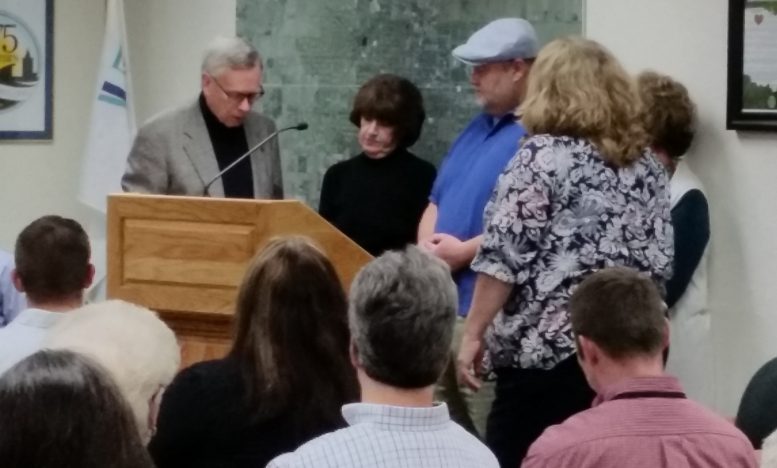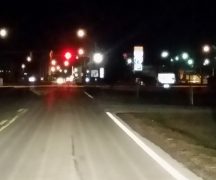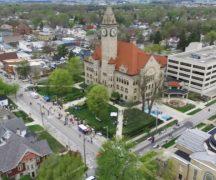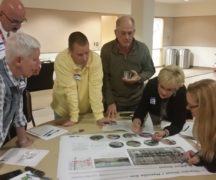By JAN LARSON McLAUGHLIN
BG Independent News
After being on the wrong side of the tracks for decades, the East Side residents of Bowling Green are gradually working to change that image. And they are hoping the city’s new Community Action Plan will push along the progress.
Since 2007, the East Side Residential Neighborhood Group has acted as a voice and unofficial ombudsman for residents on the east side of Bowling Green. In the past decade, the group has grown from a handful of people to more than 100 “dues-paying” members and many more supporters.
The group met again on Thursday, this time to hear from city officials like Mayor Dick Edwards, Municipal Administrator Lori Tretter, Assistant Municipal Administrator Joe Fawcett and Police Chief Tony Hetrick.
Tretter and Fawcett updated citizens about the Community Action Plan, specifically those sections of great importance to the East Side – the creation of a rental registration, bicycle safety programs, and over-occupancy of rental units.
“City Council is still looking at the rental registration,” Fawcett said. “They are still examining it. We have been in communication with other communities about what works for them.”
The registration is an effort to make sure rental units comply with basic health and safety standards. Participation in the registration would likely be voluntary.
While East Side residents welcome standards for rental units, there are some concerns about how effective the program will be if it’s done on a voluntary basis.
“We do want to see registration,” said Rose Hess, long-time leader of the East Side organization.
“We won’t have 100 percent compliance” if the registration isn’t made mandatory, Hess said.
Many East Side resident would like to see a program similar to the one in Amherst, Massachusetts, That registration is mandatory, with the landlords having to pay for the program, Hess said.
Concerns have been expressed, Hess said, about absentee landlords. But that isn’t a real issue, she said. The East Side neighborhood group has information on more than 600 landlords in the city.
“We have them in a database. We can track them down,” she said. “That should not be an obstacle.”
The mayor spoke about positive changes being made along the East Wooster corridor – with Bowling Green State University and landlords helping to clean up problem properties.
“There have been significant changes on East Wooster,” Edwards said, stressing the partnerships working together on the East Side. “I wanted to reassure them of the close working relationship with the university” and the new administration under BGSU President Rodney Rogers.
Hess agreed. As she and her husband, Gary, drove down East Wooster this week, she remarked, “This used to be a zoo.”
But no more.
“I think it’s wonderful. You can’t help but notice the absence of what used to be eyesores,” Hess said. “We think it’s a great start.”
East Side residents did have questions about the new pedestrian crossings on East Wooster. Tretter explained that while pedestrians from BGSU appreciate the crossings, some motorists aren’t too fond since they have to comply with the new traffic lights.
“The city gets calls complaining they have to go slow,” Hess said. “Everybody laughed. That’s the whole point.”
Fawcett talked about the city’s “Slow Roll” rides being held to make bicyclists more comfortable riding on city streets. He also dispelled the misnomer that the Yay Bikes program is opposed to bike lanes. In cases where roads are wide enough for bicyclists, the program focuses on education as a more cost-effective and more immediate solution, Fawcett said.
Police Chief Tony Hetrick reported on efforts to work with “problem homes.” Officers have focused on shutting down loud parties and making residents clean up their yards after gatherings.
“He has gotten results,” Hess said.
In one case, a landlord has reportedly told the renters that they will be evicted if the police get one more complaint.
“That was really encouraging,” Hess said.
Also at last week’s meeting, the results were reported on a survey conducted by the East Side Residential Neighborhood Group. Based on the results of the survey, it was suggested the East Side organization work with city officials to:
- Establish licensing requirements and enforcement procedures for rental properties.
- Fill the empty code enforcement position.
- Rewrite ordinances which currently allow for non-conforming zoning status in perpetuity.
- Regain a balance in the number of owner-occupied and rental properties on the East Side.
- Establish a single point of contact with the city administration for receiving and responding to public complaints.
- Develop an overall strategy for attracting young families to the area.
A small number of respondents identified other issues such as:
- Parking problems associated with rental properties.
- Pet control, including noisy and unleashed animals, and cleanup after pets.
- Inadequate enforcement of current ordinances.
Hess said the East Side organization will also start working to earn the micro-grants being handed out by the city for neighborhood projects.
“We need to get the word out to the neighborhoods,” she said.





